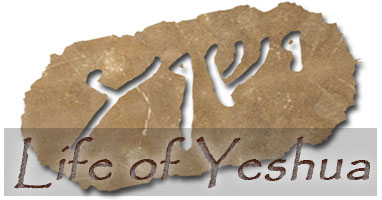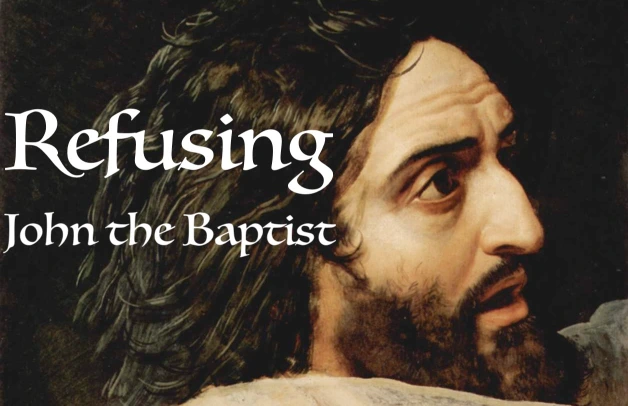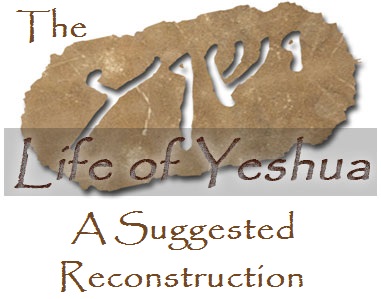How to cite this article:
Joshua N. Tilton and David N. Bivin, “Refusing John the Baptist,” The Life of Yeshua: A Suggested Reconstruction (Jerusalem Perspective, 2025) [https://www.jerusalemperspective.com/30118/].
Matt. 21:31b-32; Luke 7:29-30
(Huck 82, 203; Aland 107, 277; Crook 124, 313)[117]
| Table of Contents |
|
1. Text 3. Conjectured Stages of Transmission 5a. Luke’s Version 7. Conclusion |
Text
To view the text of Refusing John the Baptist click on the link below:
Premium Members and Friends of JP must be signed in to view this content.
If you are not a Premium Member or Friend, please consider registering. Prices start at $5/month if paid annually, with other options for monthly and quarterly and more: Sign Up For Premium
Conclusion
We find no evidence of direct dependence of either version of Refusing John the Baptist upon the other, nor do we find evidence that the authors of Luke and Matthew based their versions on a common literary source. Neither have we found that both authors were acquainted with an oral tradition in which Jesus said something about toll collectors being more receptive to John the Baptist than the Jewish authorities. Rather, it appears that both evangelists were independently familiar with an early Christian criticism of the Jewish leaders that disparaged them as being worse than toll collectors: Toll collectors responded to the preaching of both John and Jesus, but the Jewish leaders rejected John, so it is hardly surprising that they haven’t responded to Jesus either. Each evangelist independently alluded to this circulating criticism at different points in their writings where the respective authors found it to be useful to do so.
 Click here to return to The Life of Yeshua: A Suggested Reconstruction main page.
_______________________________________________________
Click here to return to The Life of Yeshua: A Suggested Reconstruction main page.
_______________________________________________________
- [1] The only other shared element in the Matthean and Lukan versions of Refusing John the Baptist is the use of terminology based on the δικαιο- (dikaio, “righteous”) root, but even here there is disagreement. Matthew says the Baptist came ἐν ὁδῷ δικαιοσύνης (en hodō dikaiosūnēs, “in [the] way of righteousness”), whereas Luke says all the people, even the toll collectors, ἐδικαίωσαν τὸν θεόν (edikaiōsan ton theon, “justified God”) by receiving the immersion of John. Given the redactional interests and motives of each evangelist, the shared use of the δικαιο- root could be a coincidence. ↩
- [2] See Harnack, 118. ↩
- [3] In the ancient manuscripts the order of the two sons is sometimes reversed. Here we follow the order of the critical texts. ↩
- [4] See Jeremias, Parables, 80; John P. Meier, “John the Baptist in Matthew’s Gospel,” Journal of Biblical Literature 99.3 (1980): 383-405, esp. 401. ↩
- [5] See Schweizer, 410. Culpepper (407) suggests that the Pharisees’ and Sadducees’ going out to where John was baptizing, described in Matt. 3:7, was tantamount to the priests and elders saying an initial “Yes” to John the Baptist. However, the two groups are different, and Matt. 3:7 does not state that the Pharisees and Sadducees went out in order to be baptized. Rather, Matthew portrays them as going out to inspect John’s activity, which is why the Baptist so harshly rebuffs them. So in every respect Culpepper’s suggestion is a stretch. ↩
- [6] See Luz, 3:31. ↩
- [7] See McNeile, 307. ↩
- [8] In Mark’s Gospel, immediately following Questioning Yeshua’s Authority (Mark 11:27-33), we read: “And he [i.e., Jesus] began to speak to them in parables [plur.]...” (Mark 12:1), but only a single parable (Wicked Tenants) is recorded. Gundry (Matt., 421) suggested that the author of Matthew inserted Two Sons ahead of Wicked Tenants in response to Mark’s misleading grammar, which led him to expect two or more parables. However, this is unlikely to be the reason. The author of Matthew moved the statement in Mark 12:1 from before Wicked Tenants to the end of Wicked Tenants (Matt. 22:1), where it was used to introduce a single parable (Great Banquet [Matt. 22:1-14]). If “speak in parables” in Mark 12:1 bothered the author of Matthew because it only introduced a single parable, the author of Matthew would hardly have written “said in parables” in Matt. 22:1 to introduce a single parable. ↩
- [9] See Knox, 2:97; Luz, 3:31. ↩
- [10] A few scholars (cf., e.g., Plummer, Luke, 205-206; Jeremias, Parables, 80; Gundry, Matt., 424) have attempted to read Luke’s version of Refusing John the Baptist as Jesus’ direct speech, but it is more natural to read these verses as an authorial aside. See Creed, 108; Bundy, 201 §111; Marshall, 297; Meier, Marginal, 2:168, 224 n. 227; Nolland, Luke, 1:342; Bovon, 1:279. See also David Flusser, Die rabbinischen Gleichnisse und der Gleichniserzähler Jesus (Bern: Peter Lang, 1981), 74 (now in English translation as The Rabbinic Parables and Jesus the Parable Teller [trans. Timothy Keiderling; Peabody, Mass.: Hendrickson Academic, 2024], 60). ↩
- [11] See Marshall, 298. ↩
- [12] On the discourse unit concerning Jesus’ evaluation of John the Baptist, see the introduction to the “Yohanan the Immerser and the Kingdom of Heaven” complex. On what may have been the original context of Like Children Complaining, see the LOY segment on Like Children Complaining, under the subheading “Story Placement.” ↩
- [13] In the entire synoptic tradition the pairing of toll collectors with sex workers is found only in Matt. 21:31, 32. ↩
- [14] The phrase ἡ βασιλεία τοῦ θεοῦ (hē basileia tou theou, “the kingdom of God”) is rare in Matthew’s Gospel, occurring only in Matt. 12:28; 19:24; 21:31, 43. There is also a textually uncertain instance in Matt. 6:33. Generally the author of Matthew used the phrase ἡ βασιλεία τῶν οὐρανῶν (hē basileia tōn ouranōn, “the kingdom of the heavens”), either because this was the phrase he found in his non-Markan source or because he wished to imitate its style. ↩
- [15] See Luz, 3:27. ↩
- [16] So Jeremias, Parables, 80. ↩
- [17] Cf. Meier, Marginal, 2:224 n. 225. ↩
- [18] Cf. Schweizer, 410. ↩
- [19] See Jeremias, Parables, 80. Cf. Harnack, 118. ↩
- [20] Cf. Schweizer, 410; Meier, Marginal, 2:224 n. 225; Luz, 3:27. ↩
- [21] We have avoided the terms “prostitute” and “prostitution” because of the negative connotations, moral opprobrium and social stigma with which they are associated. ↩
- [22] Cf. Gundry, Matt., 422. ↩
- [23] See Davies-Allison, 3:170. ↩
- [24] Cf. Nolland, Matt., 863. ↩
- [25] See Manson, Sayings, 223; David R. Catchpole, “On Doing Violence to the Kingdom,” Journal of Theology for Southern Africa 25 (1978): 50-61, esp. 55. Cf. Nolland, Matt., 861. ↩
- [26] See Kilpatrick, 30; Meier, Marginal, 2:225 n. 225; Luz, 3:27. ↩
- [27] See Fleddermann, 361. Cf. Harnack, 118. ↩
- [28] So Gundry, Matt., 422. ↩
- [29] So Flusser, Die rabbinischen Gleichnisse und der Gleichniserzähler Jesus, 74 (= The Rabbinic Parables and Jesus the Parable Teller, 60). ↩
- [30] See Bundy, 201 §111. ↩
- [31] In Refusing John the Baptist only 10.2% of Matthew’s wording is identical to Luke’s (5 words—οἱ τελῶναι | καί | δέ | καί—out of 49), and only 15.63% of Luke’s wording (5 words out of 32) is identical to Matthew’s. For these figures, see LOY Excursus: Criteria for Distinguishing Type 1 from Type 2 Double Tradition Pericopae. ↩
- [32] See Harnack, 118. ↩
- [33] Luke’s other source, the First Reconstruction (FR), did have a more polished Greek style than Anth. It is unlikely, however, that for Refusing John the Baptist (Luke 7:29-30) the author of Luke relied on FR, because the surrounding pericopae in Luke 7:11-35 were all taken from Anth., and the author of Luke tended to copy his sources in blocks, rarely inserting material from one source into a cluster of pericopae taken from another. Moreover, the high density of Lukan (as distinct from FR) vocabulary tells against FR’s being Luke’s source for Refusing John the Baptist. ↩
- [34] Cf. Bundy, 201 §111.
Some scholars have speculated that the Lukan and Matthean versions of Refusing John the Baptist can be traced back to a dominical saying in which Jesus referred to the toll collectors responding favorably to John the Baptist, but Jesus’ opponents failing to do so (cf., e.g., Harnack, 118; McNeile, 307; Bovon, 1:279). Although the statement is placed on the lips of Jesus in Matthew’s Gospel, we do not think the polemic originated with Jesus, since it is unlikely that the author of Luke would have transformed a saying of Jesus into an authorial aside. For Luke’s readers, any criticism of the Pharisees would have had much greater force coming directly from Jesus than from a side comment of the author. By the same token, it would not be at all surprising if the author of Matthew placed an early Christian critique of the Jewish authorities on Jesus’ lips, since doing so gives the critique greater punch.
For these same reasons we cannot concur with Flusser’s opinion (Die rabbinischen Gleichnisse und der Gleichniserzähler Jesus, 74 [= The Rabbinic Parables and Jesus the Parable Teller, 60]) that the author of Luke knew a version of Refusing John the Baptist more or less as it appears in Matthew. Flusser went so far as to suggest that Questioning Yeshua’s Authority, the Two Sons parable, and Refusing John the Baptist were grouped together (as in Matthew) in Luke’s non-Markan source. Cf. LHNS, 65 §82. ↩ - [35] Positing the existence of such a polemic drawn upon independently by the authors of Luke and Matthew is necessary, for otherwise the similarities between the Lukan and Matthean versions of Refusing John the Baptist are too great of a coincidence. Cf. Luz, 3:27. ↩
- [36] Cf. Creed, 108; Marshall, 298; Bovon, 1:284. ↩
- [37] See Meier, Marginal, 2:225 n. 225; Luz, 3:27. ↩
- [38] On this pre-synoptic cluster, see the introduction to the “Yohanan the Immerser and the Kingdom of Heaven” complex and Yohanan the Immerser’s Question, under the subheading “Conjectured Stages of Transmission.” ↩
- [39] The Essenes were sometimes referred to as a γένος (genos, “race”; cf. Jos., J.W. 2:113; Ant. 13:172), which seems to have given some ancient writers the impression that they were a people distinct from the Jews (cf. Pliny, Hist. Nat. 5:73). Josephus, at any rate, found it necessary to explain to his readers that the Essenes were Jews (J.W. 2:119). Might the author of Luke have been thinking that the related term γενεά (genea), which can mean “race” as well as “generation,” Jesus referred to in Luke 7:31 was the “race” of the Pharisees? ↩
- [40] Cf. Creed, 108; Fleddermann, 363. ↩
- [41] Cf. Nolland, Luke, 1:342; Fleddermann, 363. ↩
- [42] See Harnack, 119; Hawkins, 45; Marshall, 298; Fitzmyer, 1:675; Jeremias, Sprache, 165; Bovon, 1:279 n. 15; Wolter, 1:310. ↩
- [43] We found λαός to be the product of Lukan redaction in Yohanan the Immerser’s Eschatological Discourse, L1 (Luke 3:15); Yohanan the Immerser’s Execution, L2 (Luke 3:18); Sermon’s End, L6 (Luke 7:1). ↩
- [44] On the author of Luke’s redactional use of καί in the sense of “also,” see Sign-Seeking Generation, Comment to L42-43. ↩
- [45] See Jeremias, Sprache, 165. ↩
- [46] The verb δικαιοῦν occurs with a higher frequency in Luke (5xx; Luke 7:29, 35; 10:29; 16:15; 18:14) than in the Gospels of Mark (0xx) or Matthew (2xx; Matt. 11:19; 12:37). The Lukan-Matthean agreement to use δικαιοῦν in Like Children Complaining (Matt. 11:19 ∥ Luke 7:35) ensures that this verb occurred there, and likely prompted the author of Luke to use it in Refusing John the Baptist (Luke 7:29). ↩
- [47] Cf. Nolland, Luke, 1:342; Bovon, 1:279; Fleddermann, 363. ↩
- [48] Cf. Harnack, 119; Marshall, 299; Wolter, 1:310. ↩
- [49] Of the sixteen instances of verbs formed from the ט‑ב‑ל root in MT, only one occurs in the nif‘al stem (Josh. 3:15). There, it is the feet of the priests, not the priests themselves, that are immersed. Jastrow (517) does not cite any instances of ט‑ב‑ל occurring in the nif‘al stem anywhere in rabbinic literature. ↩
- [50] See A Voice Crying, Comment to L57. ↩
- [51] As an alternative to Delitzsch’s translation we might suggest rendering Luke’s Greek in L5 as ויצדיקו את אלהים לטבול טבילת יוחנן (“and they vindicated God by immersing the immersion of John”). Our translation is modeled after a verse in 1 Kings where we read:
וְשָׁפַטְתָּ אֶת עֲבָדֶיךָ לְהַרְשִׁיעַ רָשָׁע לָתֵת דַּרְכּוֹ בְּרֹאשׁוֹ וּלְהַצְדִּיק צַדִּיק לָתֶת לוֹ כְּצִדְקָתוֹ
...and may you do your slave justice by condemning the wicked by bringing his conduct upon his head, and by vindicating the righteous by giving to him according to his righteousness. (1 Kgs. 8:32)
In this verse and in our suggested translation “vindicate by doing something” is expressed as הִצְדִּיק + infinitive construct. ↩
- [52] Cf. Plummer, Luke, 206; Hawkins, 28; Bovon, 1:279 n. 15. See also Robert Leaney, “ΝΟΜΙΚΟΣ in St Luke’s Gospel,” Journal of Theological Studies (ns) 2.2 (1951): 166-167, esp. 166. The very use of the noun βουλή is unique to Luke in the synoptic tradition, occurring 2xx in Luke (Luke 7:30; 23:51) and 7xx in Acts (Acts 2:23; 4:28; 5:38; 13:36; 20:27; 27:12, 42). See Moulton-Geden, 151. Therefore, βουλή itself may be an indicator of Lukan redaction. Cf. Harnack, 119; Marshall, 299; Jeremias, Sprache, 165; Wolter, 1:310. ↩
- [53] The author of Luke had not yet composed Acts when he wrote his version of Refusing John the Baptist, but the story of Gamliel’s counsel was probably already known to him and may also have been familiar to his readers, so it is to the account in Acts, not to Acts itself, that the author of Luke would have alluded. ↩
- [54] Shared vocabulary includes Φαρισαῖος (Farisaios, “Pharisee”; Luke 7:30; Acts 5:34), πᾶς ὁ λαός (pas ho laos, “all the people”; Luke 7:29; Acts 5:34) and βουλή (boulē, “counsel,” “purpose”; Luke 7:30; Acts 5:38). Similar terminology includes νομικός (nomikos, “legal expert”; Luke 7:30) ≈ νομοδιδάσκαλος (nomodidaskalos, “law instructor”; Acts 5:34) and τοῦ θεοῦ (tou theou, “of God”; Luke 7:30) ≈ ἐκ θεοῦ (ek theou, “from God”; Acts 5:39). ↩
- [55] See our discussion of Luke’s use of νομικός in Man With Edema, Comment to L9. ↩
- [56] Harnack (119), Leaney (“ΝΟΜΙΚΟΣ in St Luke’s Gospel,” 166-167) and Jeremias (Sprache, 165-166), on the other hand, counted all instances of νομικός in Luke as the product of Lukan redaction. ↩
- [57] See Harnack, 119; Hawkins, 16; Fleddermann, 363. ↩
- [58] See Moulton-Geden, 23. ↩
- [59] On the derivation of Luke’s ἀθετεῖν saying in Luke 10:16 from Anth., see Sending the Twelve: Apostle and Sender, Comment to L141-144. ↩
- [60] See Nolland, 1:343. ↩
- [61] See Bovon, 1:285 n. 62. ↩
- [62] See Wolter, 1:312. ↩
- [63] Cf., e.g., Black, 77. ↩
- [64] See Fitzmyer, 2:676; Bovon, 1:285 n. 62. ↩
- [65] In LXX the phrase εἰς ἑαυτόν/ἑαυτούς occurs only in 2 Macc. 4:24 (Greek composition); Wis. 5:12 (Greek composition); Sir. 37:7 (translation = עליו in MS B and MS D). ↩
- [66] See Leaney, “ΝΟΜΙΚΟΣ in St Luke’s Gospel,” 166-167; Jeremias, Sprache, 165-166. ↩
- [67] See Man with Edema, Comment to L9. ↩
- [68] See R. Steven Notley, “John’s Baptism of Repentance,” under the subheading “Styles of Immersion.” ↩
- [69] See A Voice Crying, Comment to L57. ↩
- [70] See McNeile, 307; Fleddermann, 362. ↩
- [71] Examples of assimilating Markan comments into Jesus’ direct speech are found in Matt. 24:16 (cf. Mark 13:14) (see Yerushalayim Besieged, Comment to L10), Matt. 24:22 (cf. Mark 13:20) (see Yerushalayim Besieged, Comment to L55), and Matt. 24:36 (cf. Mark 13:32) (see Be Ready for the Son of Man, under the subheading “Redaction Analysis: Mark’s Version,” Comment to L8-11). ↩
- [72] In Matt. 7:19 (cf. Matt. 3:10 ∥ Luke 3:9) and Matt. 23:33 (cf. Matt. 3:7 ∥ Luke 3:7) the author of Matthew placed on Jesus’ lips words that, in his source, had been spoken by John the Baptist. Likewise, in Matt. 23:34 the author of Matthew placed on Jesus’ lips the words spoken by “the Wisdom of God” in his source (cf. Luke 11:49). See Innocent Blood, Comment to L2. ↩
- [73] Examples of the author of Matthew's placement of theological statements in Jesus’ mouth include Matt. 3:15 (see Yeshua’s Immersion, Comment to L12-22); Matt. 11:14-15 (John the Baptist Is Elijah; see the introduction to the “Yohanan the Immerser and the Kingdom of Heaven” complex); Matt. 15:24 (see Jesus and a Canaanite Woman, Comment to L12-16); Matt. 17:12 (cf. Mark 9:13; Elijah Must Come First); Matt. 19:10-12 (Eunuchs for the Kingdom); Matt. 23:8-10 (Forbidden Titles); and Matt. 28:19-20 (Great Commission). ↩
- [74] On anti-Jewish sentiment in the Gospel of Matthew, see R. Steven Notley, “Anti-Jewish Tendencies in the Synoptic Gospels,” under the subheading “Matthew and the Jewish People.” ↩
- [75] Cf. Davies-Allison, 3:169. Several instances of ἀμήν in Matthew (Matt. 6:2, 5, 16; 19:23; 25:40, 45) probably do not reflect אָמֵן (’āmēn, “Amen!”) in an underlying source. ↩
- [76] See Gundry, Matt., 422; Davies-Allison, 3:169; Culpepper, 407. ↩
- [77] Pace Vermes, Authentic, 403. ↩
- [78] Pace McNeile, 306; Manson, Sayings, 223; Luz, 3:30. ↩
- [79] See J. Gibson, “Hoi Telōnai Kai Hai Pornai,” Journal of Theological Studies (ns) 32.2 (1981): 429-431. Cf. Davies-Allison, 3:169. ↩
- [80] See Luz, 3:31. ↩
- [81] See Nolland, Matt., 863. Church tradition has sometimes cast Mary Magdalene in the role of a sex worker, but this is due to the conflation of the story of Mary, who was possessed by seven demons (Luke 8:2), the unnamed “sinful” woman who washed Jesus’ feet with her tears, wiped them with her hair and anointed them with perfume (Luke 7:37-38), and Mary, the sister of Martha and Lazarus, who anoints Jesus’ feet with nard (John 12:1-3). See Miriam Feinberg Vamosh, “Character Profile: Mary Magdalene,” under the subheading “Untangling A Mary Mix-Up.” The Gospels do not identify any of these women as sex workers. The “sinful” woman of Luke 7:37-38 may have been a sex worker, but she could just as easily have been guilty of adultery (cf. John 8:2-11), practicing magic (cf. m. Avot 2:7) or gossip (cf. m. Avot 1:5), or have been tainted by her husband’s or father’s reputation for gambling (cf. m. Sanh. 3:3) or engaging in a dishonest trade (cf. t. Dem. 2:17). ↩
- [82] Pace Davies-Allison, 3:169. ↩
- [83] See Moulton-Geden, 842. ↩
- [84] See Gundry, Matt., 422. ↩
- [85] See Choosing the Twelve, Comment to L35. ↩
- [86] See Allen, 227; Schweizer, 410; Luz, 3:27, 30. ↩
- [87] The phrase “Kingdom of God” occurs in Matt. 12:28; 19:24; 21:31, 43. There is also a textually dubious instance in Matt. 6:33. ↩
- [88] The table below shows all of the instances of the phrase ἡ βασιλεία τοῦ θεοῦ in the Gospel of Matthew and the synoptic parallels (if any):
[Matt. 6:33 DT (cf. Luke 12:31)]
Matt. 12:28 DT = Luke 11:20
Matt. 19:24 TT = Mark 10:25; Luke 18:25
Matt. 21:31 U
Matt. 21:43 TT (cf. Mark 12:[--]; Luke 20:[--])
Key: TT = pericope has parallels in all three Synoptic Gospels; DT = Lukan-Matthean pericope; U = verse unique to a particular Gospel; [--] = no corresponding verse - [89] Cf. Davies-Allison, 3:170. ↩
- [90] The table below shows all the instances of προάγειν in the Gospel of Matthew and the synoptic parallels (if any):
Matt. 2:9 U
Matt. 14:22 Mk-Mt = Mark 6:45
Matt. 21:9 TT = Mark 11:9 (cf. Luke 19:37)
Matt. 21:31 U
Matt. 26:32 Mk-Mt = Mark 14:28
Matt. 28:7 Mk-Mt = Mark 16:7
Key: TT = pericope has parallels in all three Synoptic Gospels; Mk-Mt = Markan-Matthean pericope; U = verse unique to a particular Gospel - [91] It cannot be that toll collectors and female sex workers enter the Kingdom of God because of their immoral professions (cf. 1 Cor. 6:9-10). They must have repented or demonstrated some kind of faith to qualify them for entry into God’s kingdom. ↩
- [92] Pace Harnack, 118; Jeremias, Parables, 80; Schweizer, 410; Luz, 3:27. ↩
- [93] See Yeshua’s Words about Yohanan the Immerser and The Kingdom of Heaven Is Increasing. ↩
- [94] See A Voice Crying, Comment to L37-38. ↩
- [95] Cf. Kilpatrick, 30; Gundry, Matt., 423; Luz, 3:27 n. 20. ↩
- [96] See Completion, Comment to L11. ↩
- [97] Cf. Harnack, 119; Davies-Allison, 3:170. ↩
- [98] Catchpole (“On Doing Violence to the Kingdom,” 56) suggested that “the way of righteousness” alludes to Jesus’ saying in Yeshua’s Words about Yohanan the Immerser, L22-27, according to which John is the one about whom it is written, “Behold! I am sending my angel ahead of you, who will prepare your way before you” (Matt. 11:10 ∥ Luke 7:27). ↩
- [99] Cf. Meier, “John the Baptist in Matthew’s Gospel,” 401. On this Matthean dialogue, see Yeshua’s Immersion, Comment to L12-22. ↩
- [100] Cf. Jeremias, Theology, 46; Gundry, Matt., 423; Luz, 3:31. ↩
- [101] Phrases rendered as ὁδὸς/ὁδοὶ δικαιοσύνης include אֹרַח צְדָקָה (’oraḥ tzedāqāh, “path of righteousness”; Prov. 8:20; 12:28); דֶּרֶךְ צְדָקָה (derech tzedāqāh, “way of righteousness”; Prov. 16:31); אָרְחוֹת מִשְׁפָּט (’orḥōt mishpāṭ, “paths of justice”; Prov. 17:23); דֶּרֶךְ הַשְׂכֵּל (derech haskēl, “way of understanding”; Prov. 21:16); רֹדֵף צְדָקָה (rodēf tzedāqāh, “pursuing righteousness”; Prov. 21:21). ↩
- [102] The phrase ἡ ὁδὸς τῆς δικαιοσύνης (hē hodos tēs dikaiousūnēs, “the way of righteousness”) occurs in 2 Pet. 2:21 as a description of Christian conduct. Here, too, the expression is indebted to LXX. ↩
- [103] See David Flusser, “The Magnificat, the Benedictus and the War Scroll” (JOC, 126-149), 148. Cf. Gundry, Matt., 422. ↩
- [104] See also Flusser, Jesus, 112. ↩
- [105] See Narrow Gate, under the subheading “Conjectured Stages of Transmission.” ↩
- [106] See David Flusser, “The Immersion of John and the Dead Sea Sect,” in his Jewish Sources in Early Christianity: Studies and Essays (Tel Aviv: Sifriat Poalim, 1979), 81-112, esp. 84 n. 10 (in Hebrew); idem, “The Magnificat, the Benedictus and the War Scroll,” 148 n. 54; Sandt-Flusser, 145 n. 23. ↩
- [107] Cf. Harnack, 119; Catchpole, “On Doing Violence to the Kingdom,” 55; Davies-Allison, 3:171; Luz, 3:27 n. 20; Nolland, Matt., 864; Fleddermann, 362. ↩
- [108] See Davies-Allison, 3:171. ↩
- [109] See Harnack, 119; Davies-Allison, 3:171; Luz, 3:27 n. 20; Nolland, Matt., 864; Fleddermann, 362. ↩
- [110] On the author of Matthew’s redactional use of the adverb ὕστερον, see Yeshua’s Testing, Comment to L20. ↩
- [111] See Moulton-Geden, 367. ↩
- [112] Cf. Gundry, Matt., 422. ↩
- [113] On the suggestion that “toll collectors and female sex workers” is a mistranslation of “male sex workers and female sex workers,” see Call of Levi, Comment to L10. ↩
- [114] Pace Davies-Allison, 3:169. ↩
- [115] Cf., e.g., Beare, Matt., 424. ↩
- [116] See Ilan, Women, 218. ↩
- [117] For abbreviations and bibliographical references, see “Introduction to ‘The Life of Yeshua: A Suggested Reconstruction.’” ↩





